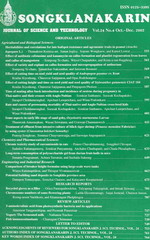ThaiScience
ThaiScience
SONGKLANAKARIN JOURNAL OF SCIENCE & TECHNOLOGY
Volume 42, No. 06, Month NOVEMBER, Year 2020, Pages 1164 - 1170
Viable but nonculturable state of escherichia coli, pseudomonas putida and lactococcus lactis during exposure to toxic chemicals, as revealed by headspace gas chromatography and indirect conductivity techniques
Panwajee Payongsri , Nattapat Charoenrat , Thunyarat Pongtharangkul and Jirarut Wongkongkatep
Abstract Download PDF
The bioconversion of water-immiscible chemicals by microbes may occur through viable but nonculturable cells (VBNC) and the evaluation of such cellular activity is important for a deeper understanding of the metabolic process. In this study, the metabolic CO2 production in a bacteria interface emulsion, consisting of bacteria, chitosan and solvent, has been monitored using headspace gas chromatography (GC) and indirect conductivity (IC). The results from GC in comparison to the standard culture technique revealed the presence of VBNC state when E. coli DH5α and P. putida F1 were in contact with nhexane. L. lactis IO-1 was the most sensitive strain, but the VBNC cells were obvious in the case of soybean and n-decane. Although GC showed better detection sensitivity, the IC technique was more practical and cost-effective. Therefore, GC and IC could be extremely simple and useful methods for monitoring the VBNC state of bacteria, which generally stems from environmental stresses.
Keywords
gas chromatography, indirect conductivity, metabolic activity, viable but nonculturable (VBNC), emulsionSONGKLANAKARIN JOURNAL OF SCIENCE & TECHNOLOGY
Published by : Prince of Songkla University
Contributions welcome at : http://rdo.psu.ac.th
